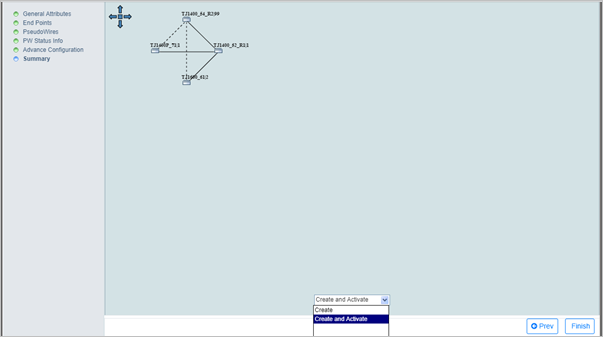Dual homing is only supported in .1q/.1ad ELINE services, MPLS-TP ELINE and MPLS-TP ELAN services.
Perform the following steps to create a dual homed ELAN Service:

> To create the service in Non Qos Domain, select the Domain as 'Non Qos Domain'.
> To create the service in Qos Domain, select the Domain as 'Qos Domain'.
> To create the service in any of the two domain, select the Domain as "All Domain'.
> To disable OAM on the service, select OAM as 'None' from drop down menu.
> To enable OAM on the service, select OAM as 'BFD Config'. Select BFD Configuration parameters displayed.
> To enable PWSM on the service, select OAM as 'Pw Status'. Select PW Status Configuration parameters displayed.
Refer to General Attributes parameters table in the topic Create ELAN services with Hub and Spoke for description of parameters on General Attributes page.
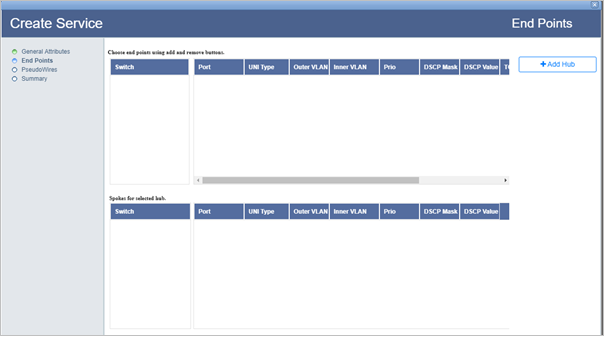
There are two ways of searching the desired node as explained follows:
> Enter the IP address/user label of the node in the text box provided and click ![]() (Search Node by IP Address or UserLabel). Or,
(Search Node by IP Address or UserLabel). Or,
> Click ![]() (Add switches using map view). Select desired NEs from the Topology selection window launched. Click Done.
(Add switches using map view). Select desired NEs from the Topology selection window launched. Click Done.
> If Domain is selected as 'Non Qos Domain' or All Domain' in General Attributes page, enter the VLAN value only under Outer VLAN column. For All Domain the UNI port can be associated with TCProfile and CoS-0.
> If Domain is selected as 'Qos Domain', enter the VLAN value under Outer VLAN column and associate a Priority Mapping Profile or DSCP Mapping Profile or a pair of TCProfile and COS values.
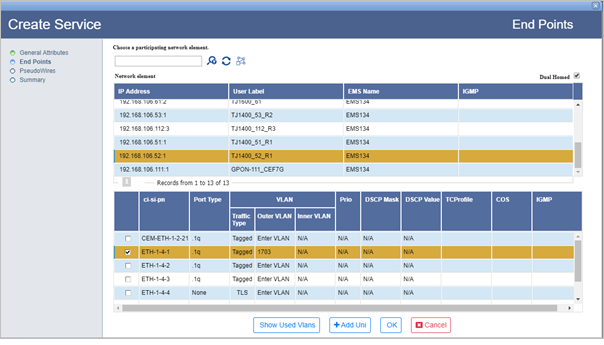
Repeat steps a to d (Step 2: Adding End Points) to add another hub to the service. Dual Homing can be enabled for this Hub also.
Following figure shows a Dual Homed Hub with two UNIs added to the service. Add Backup button will be displayed when a dual homed Hub is selected:
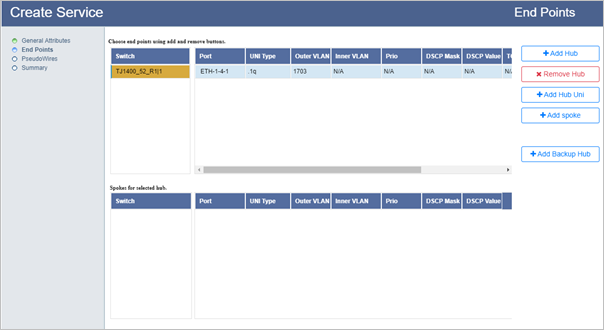
NOTE: In the image shown above, the backup is added to a single hub only. In this case, spokes with dual homed protection can be added the hub with backup only. If however, the user is looking at a load sharing scenario where the spokes with Dual Homing protection are added to both the hubs (Hub A acting as primary for half the spokes and Hub B for the other half), it would be necessary for both the hubs to have backups. In this case, Hub A and Hub B could act as each other's backup to reduce the load on single hub (in case of multiple spokes).
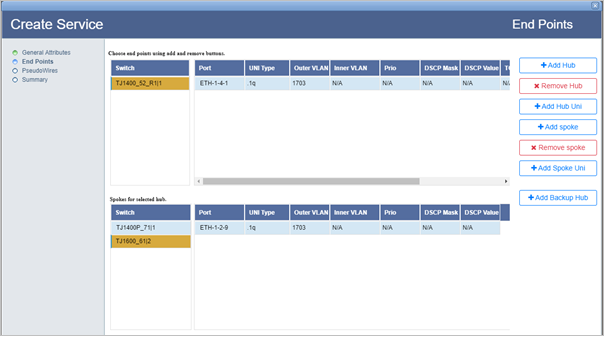
End Points parameters
Parameter |
Description |
|
|---|---|---|
Choose a participating network element. |
||
|
Search Node by IP Address or UserLabel button allows you to search the node from the network element list. Enter the IP address or user label of the desired node in the text box provided and click this button. |
|
|
Load all nodes button reloads all the nodes in network element list. |
|
|
Add switches using map view button allows you to select the switches from the topology selection window. |
|
Network element |
||
IP Address |
Displays the IP address of the node. |
|
User Label |
Displays the node label. |
|
EmsName |
Displays the EMS name in which the given node is present. |
|
IGMP |
Parameter not applicable. |
|
ci-si-pn |
Displays the shelf index, slot index and port number. |
|
Port Type |
Displays the port type. |
|
VLAN |
Traffic Type |
Allows you to select the type of traffic as 'Tagged' or 'Untagged' or 'TLS'. |
Outer VLAN |
Enter the VLAN ID. Acceptable value range from 1 to 4094 or 1 to 212 -1. |
|
Inner VLAN |
This parameter is applicable when VLAN type of port is .1ad with .1q. Then .1q VLAN is inner VLAN and .1ad VLAN is outer VLAN. |
|
Prio |
Displays the priority. Parameter not applicable, hence displays N/A. |
|
DSCP Mask |
The mask assigned for Differentiated Services Code Point (DSCP) field. Parameter not applicable, hence displays N/A. |
|
DSCP Value |
The Differentiated Services Code Point (DSCP) value defined for DEI bit. Parameter not applicable, hence displays N/A. |
|
TCProfile |
Allows to select the TCProfile created at the NMS level. Acceptable values includes a list of TC Profiles created. |
|
COS |
Allows to select an identifier for the default CoS queue to which the packet is assigned. Acceptable value ranges from 0 to 7. |
|
Priority Mapping Profile |
Allows you to associate a priority mapping profile to the selected port from the drop down list. |
|
DSCP Mapping Profile |
Allows you to associate a DSCP mapping profile to the selected port from the drop down list. |
|
IGMP |
Parameter not applicable. |
|
L2 ACL |
Parameter not applicable. |
|
Choose end points using add and remove buttons. |
||
Switch |
Displays the switch IP address of the selected node. |
|
Port |
Displays the UNI port selected for creation of end points. |
|
UNI Type |
Displays the type of switching protocol of the user network interface. |
|
Outer VLAN |
Displays the selected VLAN ID. |
|
Inner VLAN |
Displays the selected VLAN ID when VLAN type of port is .1ad with .1q. |
|
Prio |
Displays the priority. |
|
DSCP Mask |
The mask assigned for Differentiated Services Code Point (DSCP) field. |
|
DSCP Value |
The Differentiated Services Code Point (DSCP) value defined for DEI bit. |
|
TCProfile |
Displays the TCProfile selected for the UNI port created at the NMS, if any; else N/A is displayed. |
|
COS |
Displays the selected identifier for the default CoS queue to which the packet is assigned. |
|
Priority Profile |
Displays the priority mapping profile associated with the UNI port, if any; else N/A is displayed. |
|
DSCP Mapping Profile |
Displays the DSCP mapping profile associated with the UNI port, if any; else N/A is displayed. |
|
Igmp Profile |
This parameter is not applicable. |
|
Add Hub |
Add Hub button allows the user to add hub node(s) for the creation of Hub and Spoke service. |
|
Remove Hub |
Remove Hub button allows the user to remove the selected hub node chosen for Hub and Spoke service creation. |
|
Add Hub Uni |
Add Hub Uni button allows the user to add more UNI(s) to the hub node. |
|
Add Spoke |
Add Spoke button allows the user to add spoke(s) to the selected hub node. |
|
Add/Remove Backup |
Add Backup button allows the user to add a backup node to the selected Dual Homed Hub. After adding the backup node, the Add Backup is replaced by Remove Backup button using which can be used to remove the backup node added. |
|
The PseudoWires page of Create Service provides the options to add or remove protection, selection of pseudowire path manually or automatic path detection, MA configuration, and Qos Configuration.
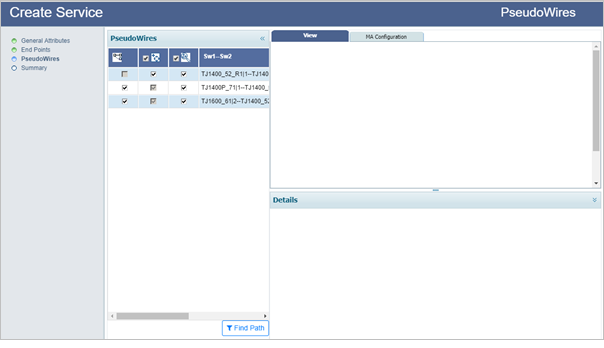
NOTE: Service creation will fail if the bandwidth defined in TCProfile attached to any UNI port in the service is not available on the port. The user can then manually assign the bandwidth value for CIR and PIR in Qos Configuration tab.
To find pseudowire path automatically,
Graphical representation of the pseudowire detected automatically is displayed under the View tab as shown in the following figure. Details of work and protect path, excluded switches, and excluded tunnels are available under Details column:
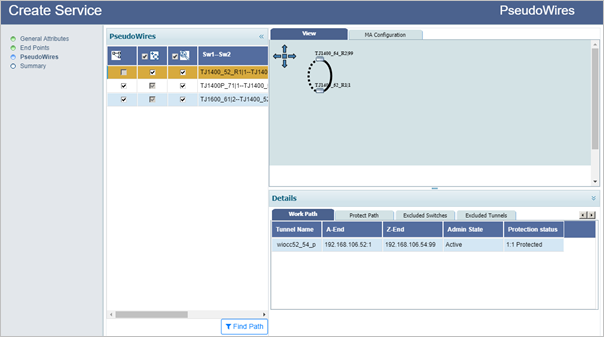
NOTE: When finding the pseudowire path automatically, the user is provided an option to exclude switches/tunnels. Select Excluded Switches and Excluded Tunnels tab. Click Add button and select the desired nodes and/links. Click Exclude Nodes or Exclude Links followed by Done. Remove button can be used to delete the added data. Select Find Path. Pseudowire path is calculated once again, excluding the selected switches/tunnels in the path.
To find pseudowire path manually,
Graphical representation of the pseudowire added is displayed on the PseudoWires page under View tab along with work and protect path details under Details column.
The PW Status Info page of Create Service is displayed if OAM was selected as 'Pw Status' on General Attributes page. It provides the option to select attachment circuits for the pseudowire end points.
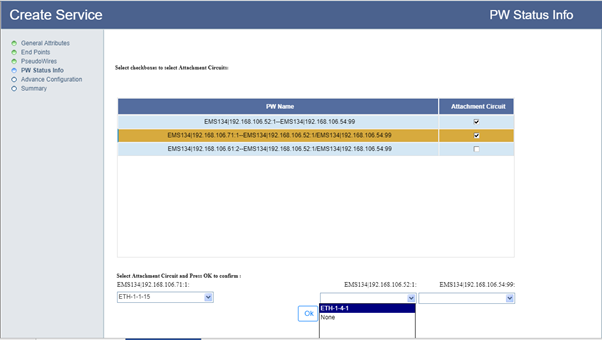
For ELAN service, repeat the two steps a and b above for adding attachment circuit to other pseudowire end points. In case if the user desires to change the added attachment circuit on a pseudowire, select that pseudowire under PW Name. The added attachment circuit will be displayed under the end points. Select another attachment circuit from the drop down menu and click OK.
On Advance Configuration window, Storm Control Configuration is performed. Select the Enable Broadcast/MultiCast Stormcontrol check box if desired and then enter the BroadCast/Multicast Stormcontrol value in Mbps in the text box displayed. Click Next to view the summary of the service.
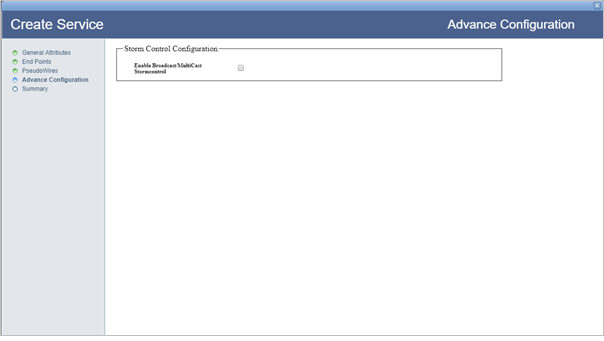
On Summary page of Create Service, the end points with the connecting pseudowire is displayed as shown in the following figure:
